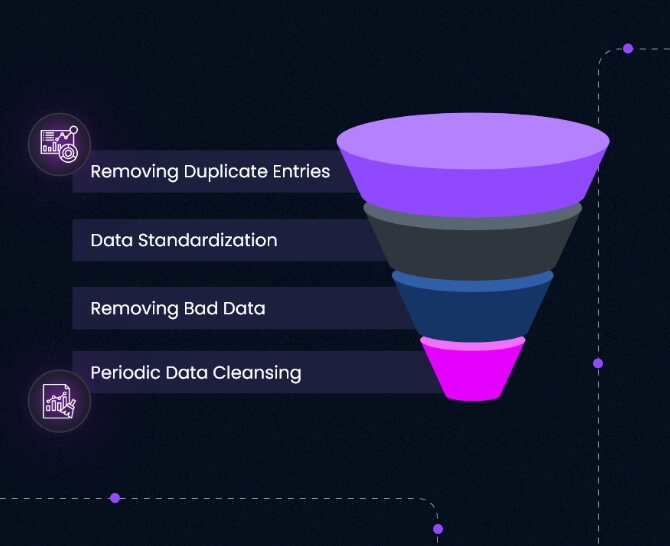
Best Practices for Data Hygiene
In a data-driven world, it is no surprise that the quality of data is paramount. To attain marketing success, quality as opposed to quantity, plays a huge role. Listed below are some best practices for data hygiene that will help businesses.
In today’s competitive market, data is the goldmine and a ticket to success. However, the biggest marketing analytics challenge faced by marketers is the quality of data at hand. It won’t be wrong to say that today’s businesses live or die based on the quality of data. Thanks to the digital-first approach that brands have adopted, the availability of data isn’t a limitation any more. It is the quality of data that decides success, and the levels of marketing automation that organizations can adopt. Quality data helps your organization guide prospects toward the bottom of the sales funnel faster and improve the bottom line.
What Is Data Hygiene?
As the term suggests, data hygiene is defined as a set of processes that improve the quality of data and make it error-free. Large volumes of data are prone to duplicate records, outdated information, and incomplete entries that hurt your brand’s overall marketing campaign. Studies show that 35% of B2B business data decays annually. Imagine the lost opportunities when the same percentage of your marketing effort goes into chasing those leads. Data hygiene cleanses your data by verifying the accuracy of the information and removing errors.
Why Does Data Hygiene Matter?
In the last few years, there has been a constant buzz around Big Data. Organizations big or small seem to be chasing this ‘Holy Grail’ to increase their footprint and leave competitors behind. While there are no two thoughts on the importance of augmenting customer information and the ‘big’ potential of Big Data, there is also an Achilles heel – bad data. In simple words, it is messy and irrelevant data integration that can lead to the wastage of precious marketing resources. It is estimated that businesses in the United States alone lose more than $13 trillion annually owing to bad data.
Data quality is thus the top priority among businesses looking to scale the ladder. As we have already stated, organizations have tons of data, and without adequate governance around data quality, this is most likely to be messy. To unlock the true potential of data, you need to clean it up regularly and enrich it with relevant customer information. This is where data hygiene plays a vital role in providing organizations with better insights into their potential customers and maximizing ROI for Businesses.
How Does Data Hygiene Help Your Campaign?
- Improves decision-making as business leaders have access to enriched data
- Updated data helps improve business processes and increase productivity
- Increases conversion rate and ROI for businesses with targeted campaigns
- Reduces wastage of precious marketing resources and improves the bottom line
- Minimizes compliance risks as mandated by GDPR and other privacy legislation
Campaign Data Hygiene Best Practices
We have already talked about data hygiene and its advantages. However, your success with data hygiene rests on adopting campaign data hygiene best practices. This not only helps in cleansing your data but also establishes rules that improve data collection and its management. Here are some of the campaign data hygiene best practices that your organization should implement –
- Data Audit
- Data Standardization
- Removing Duplicate Entries
- Updating Data
- Removing Bad Data
- Periodic Data Cleansing
If you are aware of the problem, you can solve it! Data auditing is a tedious job, especially when it is done manually. But this effort pays well by identifying broad b2b marketing trends in data inconsistency during collection, storage, and management. When you are generating data from different touchpoints, auditing can help in dealing with inconsistency. You can leverage automated data auditing tools and save on hard labor.
The best way to deal with messy data is to prevent the mess in the first place. Data standardization can go a long way in improving the quality of your data. Your organization should define data governing principles for the collection, management, and storage of data to improve its quality. Simple steps such as proper naming conventions can reduce the mess in your data.
Imagine sending identical emails to two email addresses belonging to the same customer or two sales reps calling the customer twice. It hurts your business reputation and can turn away a high-intent prospect. Duplicate entries are a nightmare for any organization, and they have to be dealt with using data hygiene.
Not all irrelevant data is bad data. Updating old data can help in turning it relevant again. Update information such as change of phone numbers, customer addresses, etc. to make it relevant again. Failure to update this information can increase the rate of decay and result in irrelevant data turning into bad data.
When it is bad, simply get rid of it. There are no incentives of holding on to outdated and irrelevant data irrespective of the effort that went into collecting it. Collate data relevant to your business process and those that are important to your customers. Avoid living with the notion of this bad data becoming a ‘goldmine’ in the future.
Data cleansing isn’t a one-time activity but a process. Your organization must set up a data cleansing schedule based on the volume of data generated, the kind of business you are in, and the sources used for data collection. By scheduling this task, you will be able to do away with discretion and ensure regular cleansing of data.
Final Thoughts
To sum up, it isn’t the volume of data that decides the success of your b2b campaign but its quality. To put this into perspective, bad data can lead an automobile business’s sales reps to market lubricants to EV owners! Data hygiene helps your sales reps have the most qualified lead Score in front of their eyes translating into higher conversions. It also drives a better customer experience and improves brand perception in the competitive market.
If you are looking to implement data hygiene across the board, we can help. At DIGGrowth we are data experts and unify your marketing data sources to offer advanced marketing intelligence that drives your sales and revenue. Our experts implement campaign data hygiene best practices to let you drill-down customer touchpoints and unearth the most qualified leads. Book a free consultation with our team by dropping an email at info@diggrowth.com.
Become a Marketer
DiGGrowth helps B2B marketers do more with less and increase marketing ROI by 30%
Get DemoAdditional Resources
15 Rules of Sales Analytics for Cleaning the Pipeline: Unearth Gold, Leave Behind Fool’s Gold Outline
As a sales manager, you already know that...
Read full post postThe OpenAI Shake-Up: Navigating Success with DiGGrowth’s Hybrid Approach
Artificial intelligence is undoubtedly a game-changer for businesses...
Read full post postEnhancing Lead Nurturing with Revenue Attribution Turning Leads into Sales
In a digital-first world, the competition has touched...
Read full post postFrequently Asked Questions
Data hygiene refers to a set of processes aimed at improving the quality of data and eliminating errors. It involves verifying the accuracy of information, removing duplicate records, and updating outdated or incomplete entries.
Data hygiene is crucial because the success of businesses depends on the quality of their data. With large volumes of data available, maintaining its cleanliness ensures accurate decision-making, improved productivity, increased conversion rates, reduced wastage of marketing resources, and compliance with privacy regulations such as GDPR.
Data hygiene plays a vital role in marketing campaigns by:
Enhancing decision-making through enriched data
Improving business processes and increasing productivity with updated data
Boosting conversion rates and ROI through targeted campaigns
Reducing wastage of marketing resources and improving the bottom line
Minimizing compliance risks by adhering to privacy legislation.
Here are some campaign data hygiene best practices:
Data Audit: Conduct regular audits to identify inconsistencies and trends in data collection, storage, and management. Automated data auditing tools can be helpful.
Data Standardization: Establish governing principles for data collection, management, and storage to ensure consistency and quality.
Removing Duplicate Entries: Identify and remove duplicate records to avoid reputation damage and confusion.
Updating Data: Keep data relevant by updating information such as phone numbers and addresses.
Removing Bad Data: Eliminate outdated and irrelevant data that serves no purpose.
Periodic Data Cleansing: Set up a schedule for regular data cleansing based on data volume and sources used.
The success of a marketing campaign relies on data quality rather than data volume. Having a large amount of data is not useful if it is inaccurate, outdated, or incomplete. Quality data ensures targeted marketing efforts, higher conversions, better customer experiences, and improved brand perception in a competitive market.
 Subhadeep Bhattacharjee
Subhadeep Bhattacharjee 

